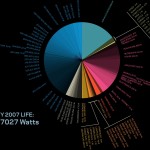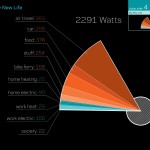 We like things simple. And relatively immediate. Safe is nice too. Sacrifice? Hopefully not.
We like things simple. And relatively immediate. Safe is nice too. Sacrifice? Hopefully not.
That’s what makes an abstract idea like climate change and the prospect of literal sea changes such an uninviting topic. The scale of the challenge can look like that wave in “The Perfect Storm”. Outside our control. Overwhelming.
Our options? Our fair share? Do less of this. Use less of that. It can sound like a scolding. It can feel like privation. So how’s this for an idea:
- Eat less and more healthy
- Exercise more
- Spend more time with my family
- Live closer together
- Spend less time commuting
- Less business travel
- Having higher quality, better designed products
- Breathe cleaner air
- Drink cleaner water
That’s what the engineer/entrepreneur and MacArthur Fellow Saul Griffith concluded when he “did the math” about the scale of the climate challenge and the actions required to respond. At the end of his obsessive exercise (he’s an engineer after all) he discovered this good news.
How did he get there? It begins with a pretty simple idea. What’s your number?
Here’s his method:
TEMPERATURE CHOICE Choose the temperature at which you would like to stabilize the earth. Acknowledge the implications (sea level rise, species loss, change to agriculture, etc.).
ALLOWABLE CARBON Determine from your choice the amount of CO2 allowed to release to the atmosphere annually
USEABLE FOSSIL ENERGY Determine the limits on our use of fossil fuels and carbon emitting sources and the amount of clean power will be needed to make up the difference
CLEAN ENERGY SOURCES What are our available clean energy options capable of providing
NEW ENERGY MIX Choose a mix of available clean energy options and estimate the industrial and engineering effort required to meet the challenge
Saul chose two degrees. As scenarios go, this one’s optimistic but achievable: “not rosy, but not a disaster.” It requires a clean energy “Renewistan” (a land area the size of Australia) and an industrial effort on the scale of our domestic response in WWII.
Now it gets personal. In that scenario the global energy capacity divided by the global population offers us each 2400 watts of energy. Oops! Saul determines he is using 17027 watts (the average for the industrialized world is 14000).
He does more math. He discovers, in scrupulous detail, how and where he is using energy. And so he proposes his diet. Dramatically less air and business travel. Less meat, more vegetables. More walking and biking. Drive slower. Less stuff (1/10 less stuff that lasts ten times as long). Now he’s using 2291 watts.
And he is living the way he wanted to all along!
Saul and his collaborators have created wattzon.com as a resource to do this kind of exercise yourself. Wouldn’t it be nice to find out that doing your fair share means living better anyway.
You can watch Saul’s full presentation at the Long Now Conference, or hear it from him as you might if you got him in a corner with a friend at a party in the video posted here.


